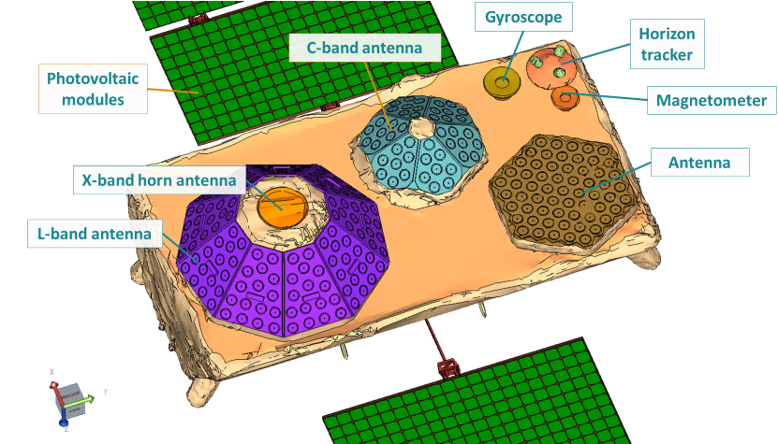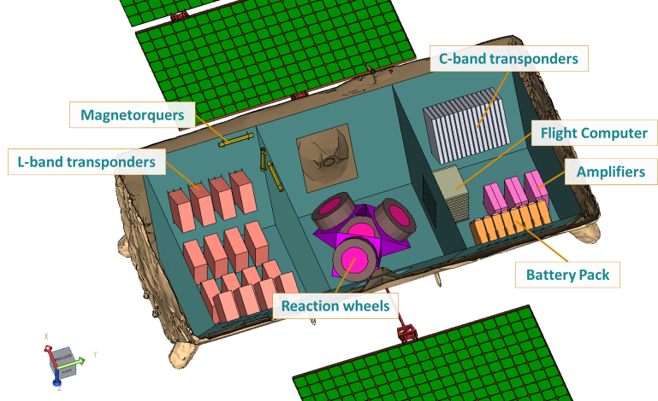Directed energy weapons (DEW), particularly high-energy lasers (HELs), are rapidly evolving, posing a significant threat to space-based assets like satellites. Understanding the thermal effects of these weapons is crucial for mission planning and developing effective countermeasures. While physical testing remains valuable, it's often impractical for scenarios involving adversarial targets or inaccessible environments. This necessitates the use of high-fidelity thermal simulation software like MuSES to predict the transient thermal impact of HELs on satellites and evaluate the effectiveness of potential countermeasures.
This blog post explores a methodology for simulating HEL attacks on orbiting satellites using MuSES, focusing on the thermal effects of a DEW on the satellite's photovoltaic (PV) solar panels. We'll review the simulation setup, including the satellite model, laser weapon parameters, and countermeasure designs, and discuss the results obtained, highlighting the importance of thermal management in satellite survivability.
Case Study: Simulating HEL Attacks on Orbiting Satellites
Our approach utilizes MuSES, a commercial thermal and infrared simulation software, to model the complex heat transfer mechanisms involved in a HEL attack. MuSES allows for detailed modeling of satellite geometry, material properties, and orbital conditions, enabling accurate transient temperature calculations. It also incorporates the thermal-electrical coupling of batteries and PV panels, providing a realistic representation of the satellite's power system.


The satellite model used in this study is a representative communications satellite, complete with PV panels, communication antennae, battery pack, amplifiers, transponders, flight computers, and reaction wheels. Each active component is assigned to a time-dependent heat rate based on a representative efficiency and mission profile, allowing for accurate calculation of the total system power draw.
The simulated HEL attack assumes a space-based platform targeting the Earth-facing side of the satellite's PV array. Key laser parameters, including power, beam focus, and time on target, can be varied to assess their impact. Using a novel numerical approach, the simulation also incorporates the effects of jitter, which refers to variations in the laser beam's aim point. Jitter can significantly affect the laser intensity profile and its impact on the target.

Countermeasure Design and Evaluation
To mitigate the thermal effects of a HEL attack, several potential countermeasures were designed and evaluated:
- Thickened Honeycomb Structure: Increasing the wall thickness of the aluminum honeycomb core within the PV panel increases its thermal capacitance, allowing it to absorb more energy before sensitive solar cells are impacted.
- Radiator Panels: Adding radiator panels to the PV array frame helps dissipate heat away from the honeycomb layer and radiate it into space. These panels are coated to minimize solar absorptivity and maximize thermal emissivity.
- Heat Sinks: Attaching heat sinks to the PV panel perimeter further enhances heat dissipation and adds thermal capacitance. Like radiator panels, these are designed for optimal radiative cooling.
- Copper Heat Spreader: A thin copper sheet is placed between the carbon fiber backing and the aluminum honeycomb to improve lateral heat conduction and distribute the laser energy more evenly.
 |
 |
 |
| Thicker Honeycomb Walls | Radiator Panels | Heat Sinks |
The effectiveness of each countermeasure is evaluated by comparing the simulated temperatures of the PV panel layers with and without the countermeasure in place.
Simulation Results and Discussion
The simulations reveal the significant thermal stress a HEL attack can impose on a satellite's PV array. Without countermeasures, the solar cell temperature can exceed the melting point of internal solder joints, potentially causing irreversible damage. The aluminum honeycomb structure is also vulnerable, approaching its melting point in some scenarios. Jitter was found to reduce peak laser intensity while increasing the spatial extent of damage, but these impacts depend on jitter severity, highlighting the importance of considering jitter effects in HEL vulnerability assessments.
The countermeasures investigated were demonstrated to provide varying degrees of effectiveness. Thickening the honeycomb structure provides some improvement, but the radiator panels and heat sinks offer more substantial protection. The combination of heat sinks and a copper heat spreader proved to be the most effective, significantly reducing the maximum solar cell temperature and keeping the PV array below the critical damage threshold. Overall, thermal capacitance was the largest contributor to countermeasure efficacy.

Conclusions and Future Directions
This study demonstrates the value of thermal simulation in evaluating the impact of HEL weapons on satellites and designing effective countermeasures. The results highlight the importance of thermal management in ensuring satellite survivability in the face of evolving threats.
While the evaluated countermeasures show promise, further research is needed to develop more robust solutions. Future studies could explore more sophisticated heat transfer mechanisms, such as heat pipes and phase change materials. It is also crucial to investigate different HEL attack scenarios, including impacts on other satellite components like the multi-layer insulation (MLI) blanket. As DEW technology advances, so must our understanding of its effects and our ability to protect critical space-based assets. High-fidelity thermal simulation is vital in this endeavor, providing a cost-effective and flexible means of assessing vulnerabilities and developing effective countermeasures.
About the Author

Dr. Corey Packard is a Principal Engineer and Director of Research & Product Management here at ThermoAnalytics. He has more than 20 years of experience in remote sensing and physics-based simulation, with his primary technical focus being EO/IR signature prediction. Other technical efforts of Dr. Packard involve field test validations, phenomenological investigations, software development support, and predicting the behavior of optical sensor systems in turbulent atmospheres and from space-based platforms.
